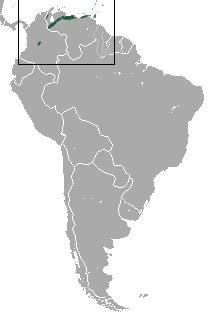Dusky slender opossum facts for kids
Quick facts for kids Dusky slender opossum |
|
|---|---|
| Conservation status | |
| Scientific classification | |
| Genus: |
Marmosops
|
| Species: |
fuscatus
|
 |
|
| Dusky slender opossum range | |
| Synonyms | |
|
M. carri (J.A. Allen and Chapman, 1897) |
|
The dusky slender opossum (Marmosops fuscatus) is a small opossum that belongs to the family Didelphidae. This family includes many types of opossums found in the Americas. This particular opossum lives in parts of Colombia, Trinidad and Tobago, and Venezuela. Sadly, its home is shrinking because of habitat loss.
Contents
What is a Dusky Slender Opossum?
Appearance and Size
The dusky slender opossum is a small mammal. It has soft, brownish fur that helps it blend into its forest home. Like other slender opossums, it has a long, thin tail. This tail can be used to help it balance as it moves through trees. It also has large eyes, which are good for seeing in the dark.
Where it Lives: Habitat and Range
The dusky slender opossum lives in tropical forests. These forests are found in specific areas of South America and the Caribbean. It prefers places with lots of trees and plants. This helps it find food and hide from predators.
Its known range includes:
- Colombia: In the northern parts of the country.
- Trinidad and Tobago: These islands are off the coast of Venezuela.
- Venezuela: Especially in the northern regions.
What it Eats: Diet
Dusky slender opossums are likely omnivores. This means they eat both plants and small animals. Their diet probably includes insects, fruits, and possibly small lizards or eggs. They use their keen sense of smell to find food at night.
How it Behaves: Lifestyle
These opossums are mostly nocturnal. This means they are active at night. They spend their days resting in hidden spots. They are also arboreal, which means they live in trees. Their agile bodies and tails help them climb and move easily among branches.
Conservation Status
Why it's "Data Deficient"
The dusky slender opossum is listed as "Data Deficient" (DD) by the IUCN. This means scientists do not have enough information about this species. They don't know exactly how many dusky slender opossums exist. They also don't know if their numbers are going up or down. More research is needed to understand their population.
Threats to Survival
Even though we don't have all the data, we know the main threat to this opossum is habitat loss. This happens when forests are cut down. People clear land for farming, building homes, or other human activities. When their forest homes disappear, these opossums lose their food sources and shelter. This makes it harder for them to survive.
See also
- Marmosops fuscatus para niños (in Spanish)


